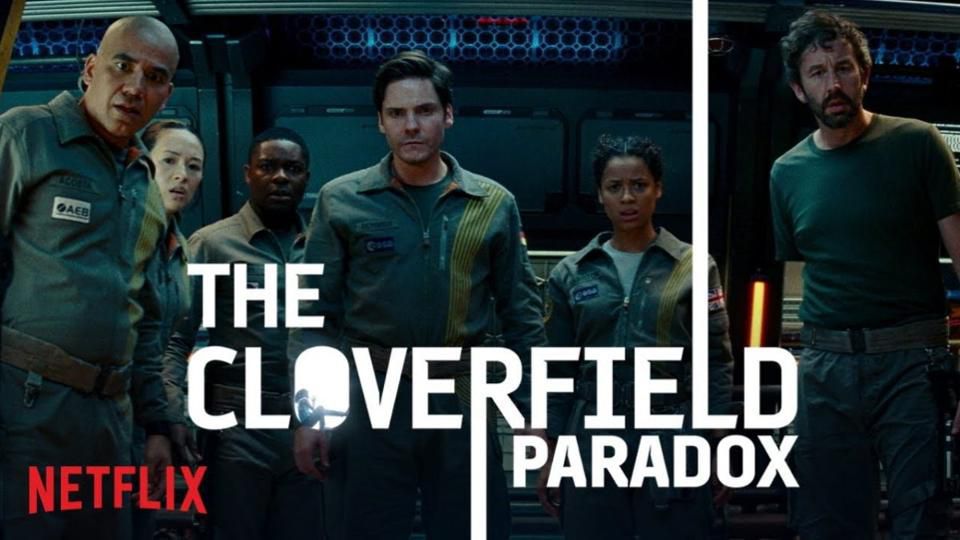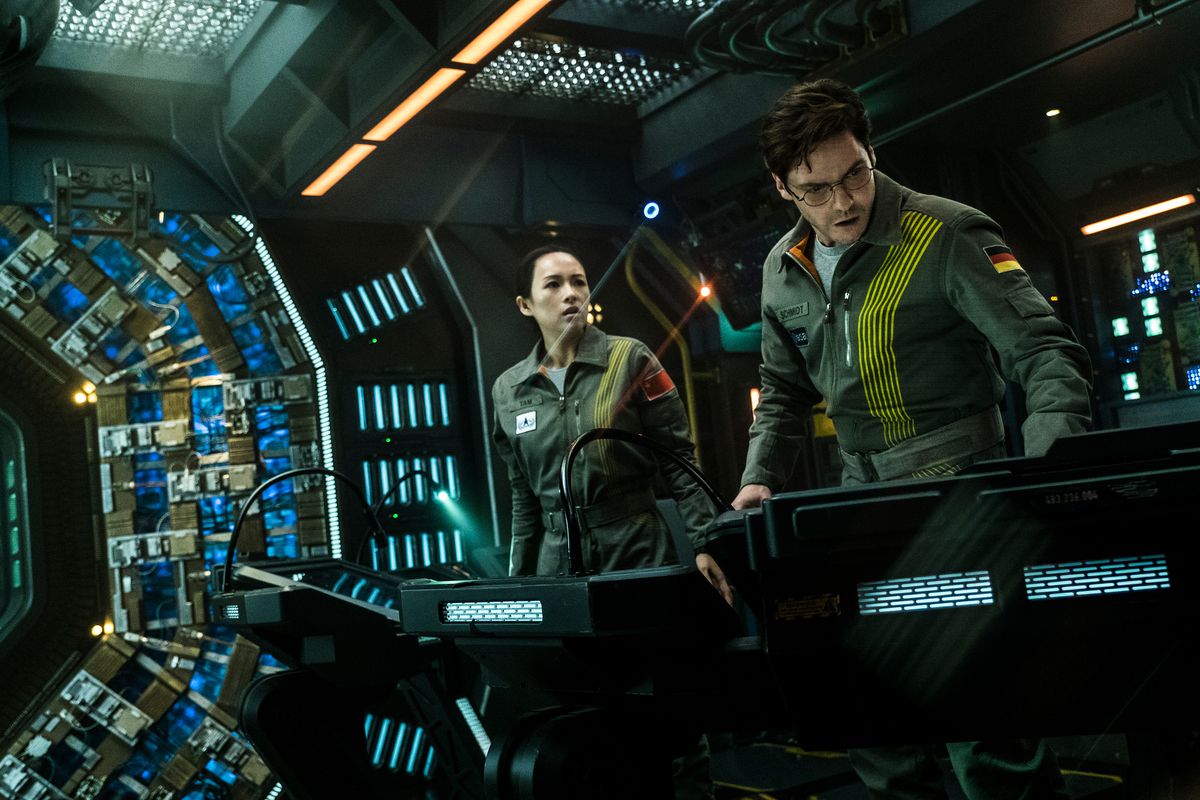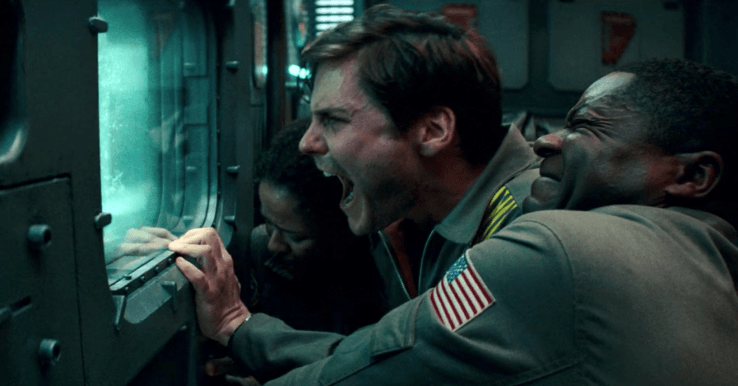
Surprise! A new film in the ‘Cloverfield’ “anthology” film series has been released with very little advance notice. This in and of itself is nice to see, from the standpoint that it’s a very different marketing strategy than most production companies and film studios are ascribing to these days. A key piece of the puzzle, though: is the film any good?
 ‘The Cloverfield Paradox’ gives us a point-of-view that we’ve yet to see in this interconnected storyline. Where the original ‘Cloverfield’ took place at “ground zero” in New York City after a mysterious monster begins to wreak havoc on the city, and ’10 Cloverfield Lane’ gives us a claustrophobic story of paranoia taking place in a bunker as the aforementioned havoc has begun, this new film takes the action out of this world – literally. The main story is set on an orbiting space station – the Cloverfield Space Station, in case you needed a more specific connection for this movie to the ‘Cloverfield’ universe – and revolves around the crew’s work towards creating a source of sustainable energy. The world is in an energy crisis, and it’s the collective hope of the understandably paranoid nations of the Earth that the equipment on-board Cloverfield can provide a solution. The equipment being used in that testing, the Shepherd Particle Accelerator, has suffered multiple failed tests over the two years the crew have been experimenting in orbit; some conspiracy theorists on the ground believe that the tests are being intentionally sabotaged, while other, further “out-there” theories believe that a successful activation of the accelerator could produce catastrophic issues in breaking the fabric between alternate universes and cause, among other things, “monsters to rise up out of the sea.” The crew does get the particle accelerator to work, but only for a moment – and in that moment, everything goes haywire. As the crew works to regroup from the power feedback, they discover that the Earth is no longer outside their window, and strange things start to happen to the crew.
‘The Cloverfield Paradox’ gives us a point-of-view that we’ve yet to see in this interconnected storyline. Where the original ‘Cloverfield’ took place at “ground zero” in New York City after a mysterious monster begins to wreak havoc on the city, and ’10 Cloverfield Lane’ gives us a claustrophobic story of paranoia taking place in a bunker as the aforementioned havoc has begun, this new film takes the action out of this world – literally. The main story is set on an orbiting space station – the Cloverfield Space Station, in case you needed a more specific connection for this movie to the ‘Cloverfield’ universe – and revolves around the crew’s work towards creating a source of sustainable energy. The world is in an energy crisis, and it’s the collective hope of the understandably paranoid nations of the Earth that the equipment on-board Cloverfield can provide a solution. The equipment being used in that testing, the Shepherd Particle Accelerator, has suffered multiple failed tests over the two years the crew have been experimenting in orbit; some conspiracy theorists on the ground believe that the tests are being intentionally sabotaged, while other, further “out-there” theories believe that a successful activation of the accelerator could produce catastrophic issues in breaking the fabric between alternate universes and cause, among other things, “monsters to rise up out of the sea.” The crew does get the particle accelerator to work, but only for a moment – and in that moment, everything goes haywire. As the crew works to regroup from the power feedback, they discover that the Earth is no longer outside their window, and strange things start to happen to the crew.
“Monsters to rise up out of the sea” – yes, that’s an actual line spoken in the film; the ‘Cloverfield’ connections are made a bit heavy-handed, just to make sure each and every viewer sees that this film is indeed a part of the over-arching cinematic universe. It wasn’t always, though; much like ’10 Cloverfield Lane,’ the film actually began its life as a movie completely independent of the ‘Cloverfield’ association. Written by Oren Uziel, the movie was acquired by production company Bad Robot (under the direction of fearless leader J.J. Abrams) and slightly re-worked to fit into the existing ‘Cloverfield’ framework. So now the question not only becomes “is the film any good?” but also “did it work?”
 The answer to both questions, really, is “sort of.” The film, on its own merits, is entertaining, for the most part; an overall solid cast performance, led by Gugu Mbatha-Raw, Chris O’Dowd, and Elizabeth Debicki, make the story enjoyable to watch and the action entertaining. Things on-screen don’t always seem like they are making sense, and most of it is explained away as “we’re in an alternate reality, so things are going to be weird,” and it’s up to you if you want to take that explanation as the rationale for the existence of plot holes. Removing three or four fairly ancillary plot points, though, effectively eliminates the movie’s ties to the ‘Cloverfield’ universe – and even the connection we are given seemingly leaves us with just as many questions as it does answers.
The answer to both questions, really, is “sort of.” The film, on its own merits, is entertaining, for the most part; an overall solid cast performance, led by Gugu Mbatha-Raw, Chris O’Dowd, and Elizabeth Debicki, make the story enjoyable to watch and the action entertaining. Things on-screen don’t always seem like they are making sense, and most of it is explained away as “we’re in an alternate reality, so things are going to be weird,” and it’s up to you if you want to take that explanation as the rationale for the existence of plot holes. Removing three or four fairly ancillary plot points, though, effectively eliminates the movie’s ties to the ‘Cloverfield’ universe – and even the connection we are given seemingly leaves us with just as many questions as it does answers.
In fact, what may be the biggest connection between this film and the others in the series – besides the ginormous wrecking-crew monster race, of course – is likely one that many viewers missed altogether. Early on in ‘The Cloverfield Paradox,’ a news reporter is interviewing one of the aforementioned conspiracy theorists; this reporter is portrayed by Suzanne Cryer, who was also in ’10 Cloverfield Lane’ in a small but memorable role as a woman who tries very hard to get John Goodman’s character to let her into his bunker. Neither character has a given name in the credits, with Cryer listed simply as “Newscaster” for this film – but it’s a fun “in joke” nonetheless.
All in all, ‘The Cloverfield Project’ is certainly a pleasant surprise in how the film was presented to the world: no trailers for fanboys to pore over for months, no needless back and forth of “what will be in the movie” and “will it make sense.” Just a movie, presented as-is, to a rather unsuspecting public forum, and hoping that we enjoy it. For this approach alone, the movie gains points with me. It’s also helpful that I did enjoy the film, even though it didn’t necessarily break any amazing new ground or give me any deep new Cloverfield-esque ideas to marinate on. For that, the film will displease some folks – and that’s perfectly understandable.
Overall, I found ‘The Cloverfield Project’ to be an above-average viewing experience; that’s my story, and I’m sticking to it.
‘The Cloverfield Project’ is now streaming on Netflix.
